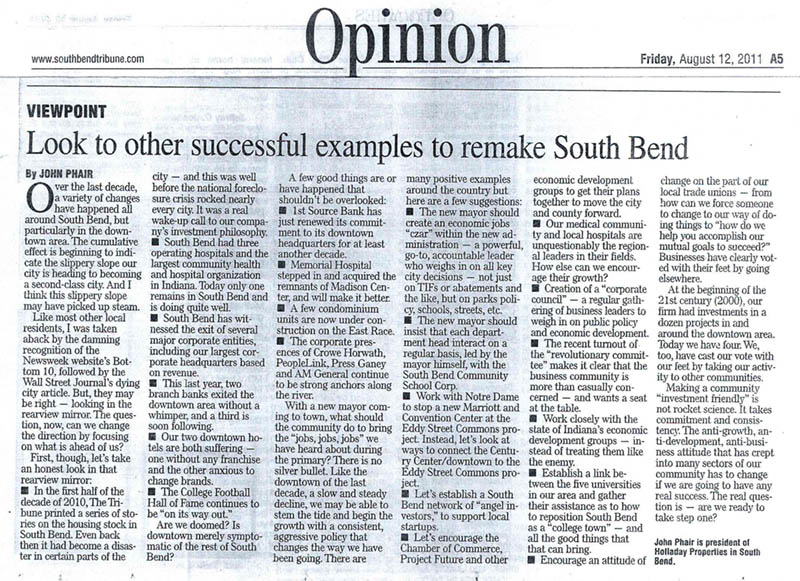The following opinion piece written by John Phair was printed in the South Bend Tribune.
Over the last decade, a variety of changes have happened all around South Bend, but particularly in the downtown area. The cumulative effect is beginning to indicate the slippery slope our city is heading to becoming a second-class city. And I think this slippery slope may have picked up steam.
Like most other local residents, I was taken aback by the damning recognition of the Newsweek website’s Bottom 10, followed by the Wall Street journal’s dying city article. But, they may be right – looking the rearview mirror. The question, now, can we change the direction by focusing on what is ahead of us?
First, though, let’s take an honest look in that rearview mirror:
- In the first half of the decade of 2010, The Tribune printed a series of stories on the housing stock in South Bend. Even back then it had become a disaster in certain parts of the city – and this was well before the national foreclosure crisis rocked nearly every city. It was a real wake-up call to our company’s investments philosophy.
- South Bend had three operating hospitals and the largest community health and hospital organization in Indiana. Today only one remains in South Bend and is doing quite well.
- South Bend has witnessed the exit of several major corporate entities, including our largest corporate headquarters based on revenue.
- This last year, two branch banks exited the downtown area without a whimper, and a third is soon following.
- Our two downtown hotels are both suffering – one without any franchise and the other anxious to change brands.
- The College Football Hall of Fame continues to be “on its way out.”
Are we doomed? Is downtown merely symptomatic of the rest of South Bend?
A few good things are or have happened that shouldn’t be overlooked:
- 1st Source Bank has just renewed its commitment to its downtown headquarters for at least another decade.
- Memorial Hospital stepped in and acquired the remnants of Madison Center, and will make it better.
- A few condominium units are now under construction on the East Race.
- The corporate presences of Crowe Horwath, PeopleLink, Press Ganey and AM General continue to be strong anchors along the river.
With a new mayor coming to town, what should the community do to bring the “jobs, jobs, jobs” we have heard about during the primary? There is no silver bullet. Like the downtown of the last decade, a slow and steady decline, we may be able to stem the tide and begin the growth with a consistent, aggressive policy that changes the way we have been going. There are many positive examples around the country but here are a few suggestions:
- The new mayor should create an economic jobs “czar” within the new administration – a powerful, go-to, accountable leader who weighs in on all key city decisions – not just on TIFs or abatements and the like, but on parks policy, schools, streets, etc.
- The new mayor should insist that each department head interact on a regular basis, led by the mayor himself, with the South Bend Community School Corp.
- Work with Notre Dame to stop a new Marriott and Convention Center at the Eddy Street Commons projects. Instead, let’s look at ways to connect the Century Center/downtown to the Eddy Street Commons project.
- Let’s establish a South Bend network of “angel investors,” to support local startups.
- Let’s encourage the Chamber of Commerce, Project Future and other economic development groups to get their plans together to move the city and county forward.
- Our medical community and local hospitals are unquestionably the regional leaders in their fields. How else can we encourage their growth?
- Creations of a “corporate council” – a regular gathering of business leaders to weigh in on public policy and economic development.
- The recent turnout of the “revolutionary committee” makes it clear that the business community is more than casually concerned – and wants a seat at the table.
- Work closely with the state of Indiana’s economic development groups – instead of treating them like the enemy.
- Establish a link between the five universities in our area and gather their assistance as to how to reposition South Bend as a “college town” – and all the good things that that can bring.
- Encourage an attitude of change on the part of our local trade unions – from how can we force someone to change to our way of doing things to “how do we help you accomplish our mutual goals to succeed?” Businesses have clearly voted with their feet by going elsewhere.
At the beginning of the 21st century (2000), our firm had investments in a dozen projects in and around the downtown area. Today, we have four. We, too, have cast our vote with our feet by taking our activity to other communities.
Making a community “investment friendly” is not rocket science. It takes commitment and consistency. The anti-growth, anti-development, anti-business attitude that has crept into many sectors of our community has to change if we are going to have any real success. The real question is – are we ready to take step one?

